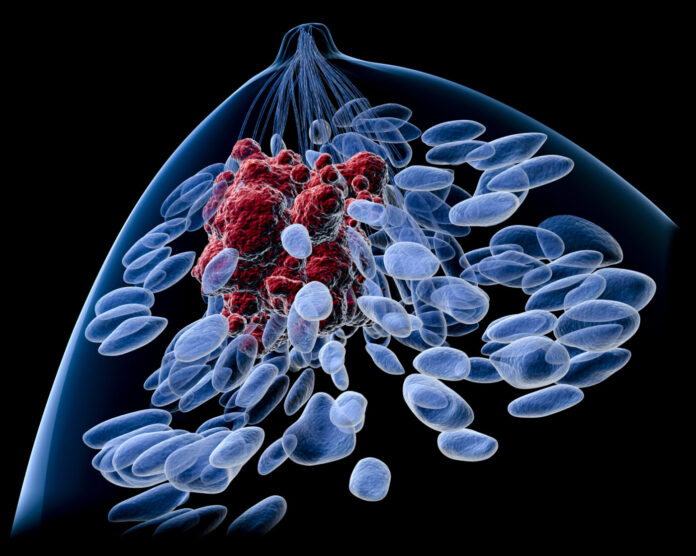The bones are the most common place where metastatic breast cancer cells tend to go. Common treatments for metastatic breast cancer in any location including the bone are chemotherapy, hormonal therapy, targeted therapies, and bone-strengthening medication. Often, bone metastases can be stabilized and managed for long periods of time. However, some breast cancers return after therapy. Now two studies led by Baylor College of Medicine (BCM) may explain why estrogen receptor-positive (ER+) breast cancer sometimes returns in the bone and spreads to other tissues despite effective endocrine therapies directed at ER.
Using animal models that include patient tumor samples, the researchers discovered that the bone microenvironment surrounding ER+ breast cancer cells reduced ER expression in these cells, leading to resistance to endocrine therapy. Their findings were published in the journal Developmental Cell in a paper titled, “The bone microenvironment increases phenotypic plasticity of ER+ breast cancer cells.” In a second study, researchers reported how the bone microenvironment promotes reprogramming of the cancer cells that support their ability to metastasize in the paper titled, “The bone microenvironment invigorates metastatic seeds for further dissemination,” published in the journal Cell.
“Metastasis to other organs is the major cause of cancer-related deaths, and my lab has been interested in this phenomenon for many years,” explained corresponding author Xiang H.-F. Zhang, PhD, the William T. Butler, MD, endowed chair for distinguished faculty and professor of molecular and cellular biology at BCM. “Breast cancer mostly metastasizes to the bone; however, it has remained a mystery why, in more than two-thirds of cases, metastases will not be limited to the bone, but rather subsequently occur in other organs and eventually cause death.”
In the two studies, the researchers applied a series of models and techniques they had previously developed to determine cancer-bone interactions at a single-cell resolution to observe what happens to ER+ breast cancer cells when they metastasize to the bone. They wanted to find out what might contribute to their resistance to endocrine treatment and enhance metastasis to other organs.
“Using several approaches, including parabiosis and an evolving barcode system, we demonstrated that the bone microenvironment facilitates breast and prostate cancer cells to further metastasize and establish multi-organ secondary metastases. We uncovered that this metastasis-promoting effect is driven by epigenetic reprogramming that confers stem cell-like properties on cancer cells disseminated from bone lesions,” wrote the researchers.
“Surprisingly, we discovered that when ER+ breast cancer cells locate in the bone, they reduce their expression of ER, which makes them less susceptible to endocrine therapies directed at ER,” added author Igor Bado, PhD, a postdoctoral fellow in the Zhang lab. “We determined that osteogenic cells, the cells that make new bone, promoted this change in the cancer cells both by releasing factors and by direct physical interaction with the cells.”
The interaction with osteogenic cells also initiated changes in gene expression that gave the cancer cells stem cell-like properties, such as unchecked self-renewal and differentiation into various cell types.
The researchers discovered a number of metabolic pathways that were altered in cancer cells by the bone microenvironment. “Using multiple approaches, including an evolving barcoding strategy, we demonstrated that this process is independent of clonal selection, and represents an EZH2-mediated epigenomic reprogramming. EZH2 drives ER+ BMMs toward a basal and stem-like state. EZH2 inhibition reverses endocrine resistance,” noted the researchers.
Numerous studies have highlighted the role of EZH2 in cancer development and have reported that EZH2 promotes cell survival, proliferation, epithelial to mesenchymal, invasion, and drug resistance of cancer cells.
“EZH2 is emerging as a leading candidate for therapeutic intervention,” added Zhang.
Weijie Zhang, PhD, co-first author of the work and a postdoctoral fellow in Xiang Zhang’s lab, noticed these findings correlated with the work he was doing. “We were studying whether bone metastases, as compared to a primary tumor, were more likely to further disseminate to other organs,” noted Weijie Zhang. “We found that the bone microenvironment is like a ‘powering station’ for cancer cells, enhancing their ability to further disseminate to other organs. Our findings support the idea that many metastases may be initiated, not by primary tumors, but by further spread of other metastases.”
These studies shed light on the bone microenvironment in metastasis progress and may lead to new treatments and strategies for resistant breast cancers.


